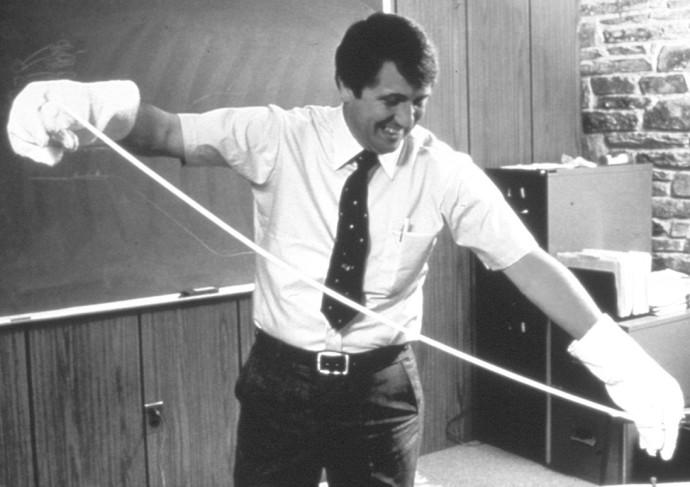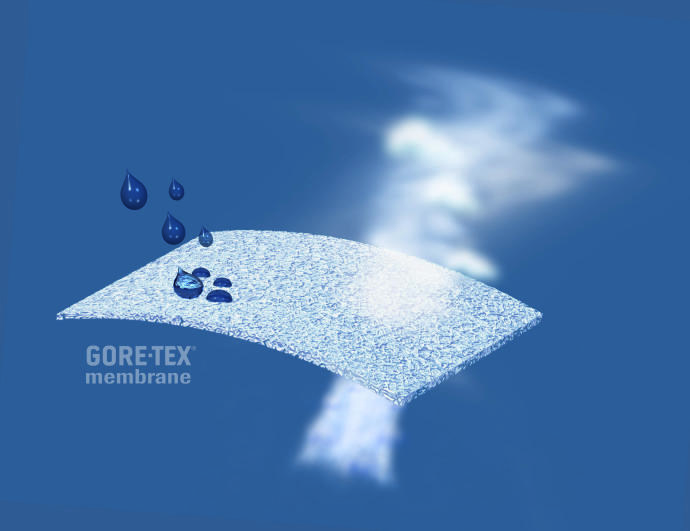“Membrane” is a term that comes up when we speak of functional, weather-protective apparel – that is, clothes that protect from rain, wind or cold, but is still breathable. A membrane is a thin layer of fabric that affects the transfer of heat and mass. The term “membrane” stems from Latin (lat. Membrāna) and basically means a thin skin-like film. One finds membranes in nature: A semipermeable membrane surrounds every biological cell. “Semipermeable” means to allow certain substances to pass through but not others. There are numerous applications for membranes in technology: They are used as a separating layer, also with semipermeable characteristics.

How does a membrane work?
In the early 1990s, I worked at a sports apparel brand. A rep of functional fabrics approached us and wanted to palm off some waterproof/breathable fabrics. Honestly, I couldn’t believe that there was actually a fabric that would allow water vapour to pass through yet would remain waterproof. “Impervious is impervious,” or so I was convinced. When it came to waterproofness, I could however be easily convinced: Without damage to a fabric, it certainly wasn’t possible to get water to pass through functional fabrics.
But what about this breathability thing?
I decided to make a few sample pieces and to test them outdoors. It actually worked! I didn’t get too hot in the jacket, particularly in comparison to a raincoat. Indeed, I felt more comfortable. But I could also actually see the moisture that came through the jacket as it condensed on a cold windowpane. Membranes in functional apparel have a simple goal: They should keep out rain and snow, and moisture that comes from sweat should be able to escape. They are thus selectively permeable. That’s what makes apparel with membranes something special. They bring together two characteristics that were long considered complete opposites. There’s always been waterproof clothing. Earlier, people protected themselves from the weather with fur, oily wools or waxed cotton. Later, with the discovery of synthetics, came raincoats made from rubber. Whilst some materials certainly offered better protection than others, all had difficulty more or less dealing with warmth and moisture accumulating inside. This raincoat can be like your own personal sauna. Such materials are still used today, for example, for small children for extremely durable overpants or mud pants. They provide extraordinary protection from weather and mud, but kids sweat a lot in them. Apparel such as softshells, fleece pullovers or insulating midlayers – so-called “puffball” jackets – can be extremely comfy. But if it gets windy, rains for a longer period of time, or snows, the fun is done. You just get cold in the jacket. Membranes prevent wind and water from permeating outerwear, yet still allow moisture exchange. And that means a bit more comfort than a rubber slicker. You can stay outside longer, and you have more endurance, and simply a lot more fun too.
So, it’s the membrane that protects me from wind and weather?

The membrane alone would be too fragile. That’s why it’s bonded with at least one other fabric layer. The joining of membrane and fabric is called “lamination,” thus the reason it is called a “laminate”. For this reason, the membrane isn’t visible. Rather, it’s hidden between the visible outer fabric and the lining.
OK, fine, but what about the seams?
When manufacturing apparel, the laminate is cut and sewn together. In the process, the membrane is pricked with a needle. At those points, the membrane is no longer waterproof. In addition, the thread goes through these holes, which acts as kind of a wick for moisture. Water immediately gets through. For that reason, the seam must be sealed with seam tape after sewing so water can’t get through anymore through the holes created by sewing. Seams sealed in this way are called “welded” or simply seam-sealed or taped because the tape is applied using heat and pressure to “weld” it to the laminate. In sum: All apparel seams through which water could penetrate must be completely seam-taped. A membrane in functional apparel prevents the penetration of wind and weather. Nevertheless, it also enables the moisture transfer from inside to outside, letting moisture from sweat escape without giving up any weather protection.





